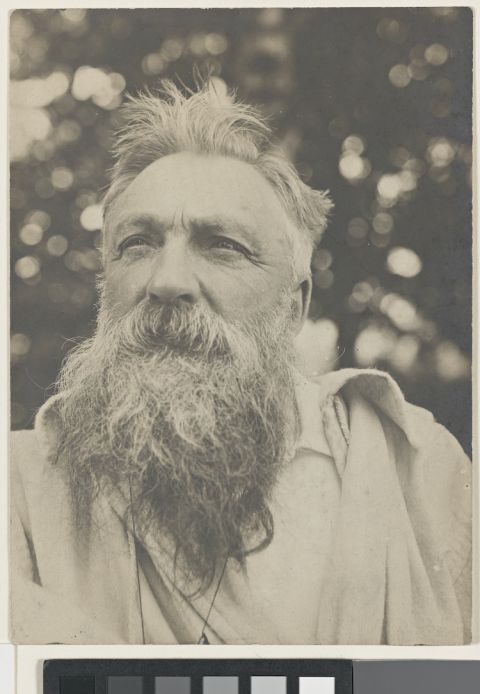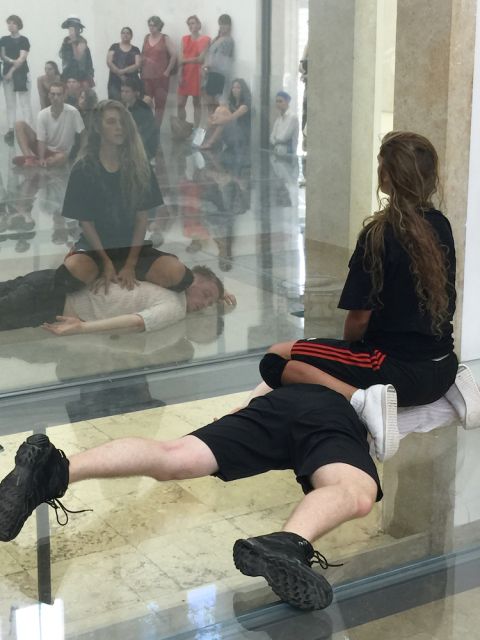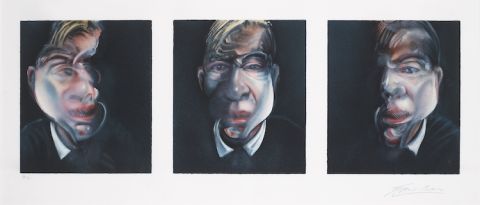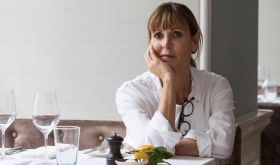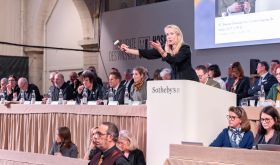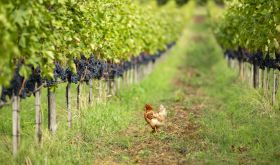Yesterday was a cause for celebration in the UK when museums and galleries reopened to the public at last. Virtual culture, however varied and far-reaching, does not have the sensual tactility of entering a gallery and experiencing the real thing. In Paris, museums open tomorrow 19 May, while in Portugal they have been open for a while. To celebrate I’ve paired six provocative exhibitions to enjoy in three river cities – London, Paris and Oporto – with an equally stimulating wine to taste after viewing.
After harrowing experiences growing up in Nazi Germany and serving in the Second World War, years before ecology became centre stage, iconic artist Joseph Beuys was a founder member of the German Green Party. Beuys’ 7,000 Oaks land art project in 1982, a regenerative work, was designed to have a lasting impact on the urban landscape of the central German city of Kassel. Beuys intended to subsequently roll out tree-planting at different urban locations throughout the world. We can never have too many trees in our cities.
British artist team Heather Ackroyd and Dan Harvey (seen above in © Tate Photography's image by Seraphina Neville) are co-founders of Climate Declares Emergency and creators of ‘strategic plans for individuals and organisations to contribute to sustaining the planet’. In response to our galloping climate emergency they have installed Beuys’ Acorns on the south terrace of Tate Modern in London until 14 November. A living sculpture – 100 oak trees grown from acorns gathered by the artists from Beuys’ original oaks in Kassel – Beuys’ Acorns are installed directly above Beuys’ work about renewal, The End of the Twentieth Century.
In 1983 Beuys created a limited edition of 200 bottles of organic Montepulciano. Ortega 2019 is a wine I feel Beuys would have enjoyed for its vineyard’s organic character and urban setting. It is a light varietal white from Forty Hall Community Vineyard, the only vineyard in London still in existence, and is certified organic. The ripe grapes are driven to Will Davenport and pressed at his winery on the same day as picking. £16.50 Forty Hall Vineyard.
Across the river at Tate Britain, the Portuguese artist Paula Rego retrospective runs from 7 July to 24 October. Rego has spent much of her life in London; she studied at the Slade School of Art before working with David Hockney and Frank Auerbach as a member of the London Group. Rego’s powerful images exploring women’s place in society are a defiant critique of repressive structures including the Salazar regime and the Catholic church. Rego’s protagonists are in turn abused, possessed and manipulated, as she draws on her own turbulent biography, literature and folk tales to combat intellectual, emotional and sexual lockdown. The works shout with rebellious intensity and roar with passion.
Paula Rego might admire the passionate individuality of Douro winemaker Rita Marques. Conceito Tinto 2017 is a field blend from 80-year-old vines at Quinta do Cabido. Complex and intense, 14%. Contact Raymond Reynolds for UK stockists. $41.99 from Wine.com in the US.
In Paris, two splendid townhouses, Musée National Picasso-Paris on the right bank and Musée Rodin on the left bank, are hosting a glorious double bill, Picasso – Rodin, drawn from their collections, until 2 January 2022.
Auguste Rodin and Pablo Picasso were both controversial during their lifetimes, frequently causing raised eyebrows for many an arbiter of conventional taste, as ever more experimental and disruptive works poured from their studios.
Rodin once wrote, ‘the imagination of the spectator should be left free to roam at will. The form created should furnish a pretext for the unlimited development of emotion’. He could have been writing about wine.
Early in his life, a doctor advised Picasso to enjoy ‘plenty of sex and red wine’. Arguably Picasso took more from women than from wine, although he was often happy to pop a bottle or glass of wine into one of his paintings. When Baron Philippe de Rothschild asked Picasso to design a label for the 1973 vintage of Ch Mouton Rothschild, true to form the 90-year-old artist drew a romping Bacchus.
In Picasso’s day, Málaga, the artist’s birthplace, would have signified the eponymous sweet fortified wine. Today the region also produces excellent dry reds. Mainly small productions, they can be difficult to find but I have chosen a 2016 Bodegas Bentomiz, Ariyanas Naturalemente Dulce, available in a 500-ml bottle from The Sourcing Table, for £24.
The Palais de Tokyo, on Paris’s right bank, has given subversive German artist Anne Imhof carte blanche to invest every nook and cranny of its extensive exhibition spaces with her choreographed, extensive performances and installations. If past exhibitions are anything to go by, expect live actors looking straight out of a Calvin Klein ad: lean, listless, detached. Audiences unwittingly become part of the performance as they follow the action from room to room. Anyone used to wine tastings ought to do fine. A friend who saw Imhof’s Golden Lion-awarded Faust at the 2017 Venice Biennale assures me that this exhibition, on until an as-yet-unspecified date in autumn, will be a gritty, edgy must-see.
I am pairing Imhof with an equally edgy wine. Kranz 2015 Arzheimer Am Fürstenweg Spätburgunder Premier Cru Dry is tense. Comes with bite. £25.20 from The Wine Barn.
Lastly two exhibitions in my home city of Porto/Oporto: World of Wine, the new wine-centric cultural centre in the Vila Nova de Gaia district of Porto, hosts the graphic works of British artist Francis Bacon to 26 September.
Bacon, charismatic and dark-souled, fortunately needed very little sleep. Mornings might be spent creating his Screaming Popes or painting his partner George Dyer, who had famously literally crashed into Bacon’s life when he fell through the skylight of Bacon’s studio attempting a burglary. In the afternoons Bacon would head to the pubs and clubs of Soho, the epicentre of London’s high and low bohemia in the mid twentieth century. Here, wrapped in a louche black leather jacket, Bacon, always an amusing conversationalist, would entertain his friends. Bacon also spent time in Paris. Art historian Michael Peppiatt has written of monumental evenings carousing with his painter friend. These escapades would typically begin with champagne cocktails in a glamorous bar such as that of The Ritz, after which the pair weaved and swerved across Paris, scarcely avoiding hooting taxis, to drop in for a drink or three at a series of decreasingly grand venues, before ending up, hours after most places had shut, in a basement dive where anything liquid would do.
Bacon might possibly have considered the just-launched Taylor’s Chip Dry & Tonic, a 5.5% mix of white port and tonic water in a 250-ml recyclable can, a little light. I can vouch that it is highly refreshing. David Guimaraens, Taylor’s head winemaker, describes the mix as ‘bursting with character’. Available in the UK from May, and US from July.
Across the River Douro, Museu da Misericordia is showing a fortifying double bill, Alberto Giacometti – Peter Lindbergh, sponsored by Taylor’s port, to 24 September. This exhibition follows the Taylor’s-sponsored 2019 exhibition of Picasso’s Vollard Suite of etchings, and we can expect to see further art gems over the next few years. Aside from the excellent Serralves Foundation, Porto has hitherto been short on international modern-art exhibitions so this is a welcome move.
Swiss-born Alberto Giacometti never met Rodin, who died a few years before Giacometti arrived in Paris, but he did hang out with his fellow left-bank immigrant Picasso. Although they enjoyed each other’s company, the two men were not always on the same page: Giacometti criticised Picasso for being decorative, while Picasso considered Giacometti obsessive.
The American writer James Lord would undoubtedly have agreed with Picasso’s description of Giacometti. A Giacometti Portrait, a fascinating, slim volume by Lord, recounts 18 days during which Lord paid a daily visit to Giacometti’s studio to have his portrait drawn. At the end of each day, Giacometti seemed at last to have achieved perfection, or at least in Lord’s opinion. The following morning, however, the model would arrive at the studio to be informed by his friend that he had just destroyed the previous day’s work in despair at its inadequacy. Giacometti would light the first of many cigarettes and the uncomfortable sittings would resume all over again. Giacometti was constantly dissatisfied with his work. His bent figures embody the harassed insecurity of twentieth-century humankind.
A man who enjoyed a smoke while modelling the glorious sensory organ that is the nose, Giacometti would have appreciated an Antinori, Pian delle Vigne Brunello di Montalcino 2014. A pronounced nose of red fruit with hints of tobacco. 100% Sangiovese. £45 from Winedirect in the UK, $39.95 from Hooked On Wine in US.
The German photographer Peter Lindbergh, who died in 2019, is principally known for his work as an international fashion photographer. Working mostly in black and white, in Lindbergh’s opinion ‘fairer’ to the subject than colour photography, his magazine cover images were instrumental in creating the 1990s supermodel, the girls whose faces ‘launched a thousand perfumes’.
One of Lindbergh’s final projects was to photograph Giacometti’s work at the Fondation Giacometti in Paris. This beautifully installed exhibition creates an arresting dialogue between the two artists’ work. A roof terrace has been opened at the top of Misericordia where visitors can taste a glass of Taylor’s port and gaze out across the beautiful city of Porto.
To illustrate that good wine does not have to come with a supermodel price tag (or be paid for with a credit card whipped out of a diamond-encrusted ostrich-skin wallet), how about a Vasse Felix, Filius Chardonnay 2019, from Margaret River, in Western Australia. Masses of mouth-watering natural acidity. Currently on offer at £12.99 from Waitrose Cellar in the UK, $20.99 from International Wine Shop in the US.



